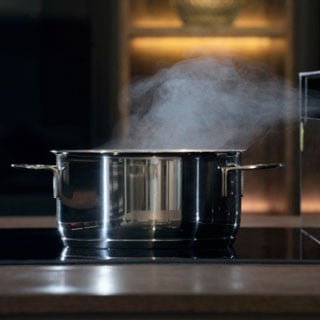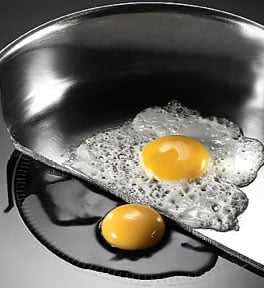The Buyer's Guide to Induction Cooktops

A Cleaner, Safer, and More Efficient Way to Cook
From family mealtimes to holiday traditions, the kitchen is the heart of the home for many. What if you could cut your time cooking and cleaning in half to enjoy more of these moments – all while creating a healthier and safer home? That’s the power of induction cooking.
Though just 3% of homes in the U.S. have induction cooktops, nearly 70% of respondents are considering induction for their next stove, according to the 2022 Consumer Reports American Experience Survey[1]. The rise of induction may be new in the U.S., but the emission-free technology, which was introduced at the Chicago World’s Fair in 1933, is used in over 35% of European homes[2].
This guide will cover the ins and outs of induction cooking, from how the technology works to its benefits and what to consider when comparing induction cooktops. Chef Lorenzo Beronilla, winner of “Top Chef Amateur”, also weighs in on the advantages of induction and why it makes a better cooking experience.
In This Story
- Induction, Induction, What’s Your Function?
- Reasons for Making the Switch to Induction
- How to Choose the Right Induction Cooktop
- Increasing New Yorkers’ Access to Induction Cooking
- Induction Cooking in Action
- More on Energy-Efficient Appliances
Induction, Induction, What’s Your Function?
Induction works by “inducing” an electromagnetic current that’s created by a metal coil inside the cooktop and transferred directly to metal pots and pans on its surface. This process creates heat within the cookware itself, and as it heats up, it cooks or boils whatever food or liquid it contains. The glass-ceramic surface underneath the cookware isn’t directly heated through the induction process, improving efficiency and kitchen safety.
If you’ve ever powered up your phone on a wireless charger, you’ve used induction technology.
Like traditional electric or gas stoves, induction stoves typically have designated spots, called cooking zones, to place pots or pans. A key difference with induction is that these cooking zones won’t heat up unless induction-compatible cookware is on the surface acting as the conduit for creating heat.
Cast iron, enameled cast iron, and many types of stainless-steel cookware are compatible with induction cooking. To check, “test your pans by putting a magnet on the bottom” to see if it sticks, advises Chef Lorenzo.
Reasons for Making the Switch to Induction
No matter your cooking habits, there’s a lot to love about induction ranges. Here’s a look at the key benefits of induction cooking compared to conventional electric and gas stoves.
1. Faster and More Precise Cooking

Once cookware meets the cooktop surface, induction makes quick work of raising the heat. An induction cooktop can bring a pot of water to boil in 2-3 minutes, or roughly 20-40% faster than gas and conventional electric cooktops[3].
While induction can rapidly crank up the heat, this responsiveness works in the other direction, too, when lowering the temperature. The precise temperature control and even heat distribution afforded by this direct heating method make it easy to maintain a simmer without burning food or having to monitor a flickering flame.
“With induction, it’s an open your refrigerator and throw everything in together kind of thing,” says Chef Lorenzo Beronilla during an induction cooktop demonstration at the Troy Farmers Market. According to Chef Lorenzo, there’s no need to wait for onions to get translucent before adding the remaining ingredients for his pork and potato egg rolls, since the precise temperature control prevents food from charring.
Preparing your go-to meals on a new induction cooktop can take some experimentation with the power settings to find the optimal temperature, so it’s worth being extra attentive as you get acclimated.
2. Health and Safety Benefits
The fact that induction can’t start – or continue operating – when cookware is removed is effectively a built-in safety feature that prevents a cooktop from being turned or left on accidentally.
Because induction only heats the cookware, the rest of the surface keeps relatively cool, significantly reducing the chance of getting burned by touching the cooktop. This, plus the absence of an open flame, means that leaving items like a spatula or dish towel on the cooktop won’t damage them or risk a fire.
Research shows that gas stoves leak harmful pollutants ![]() , including carbon monoxide and benzene, even when they are turned off. Whereas induction cooktops, combined with ventilation, help preserve your home’s indoor air quality.
, including carbon monoxide and benzene, even when they are turned off. Whereas induction cooktops, combined with ventilation, help preserve your home’s indoor air quality.
3. Greater Efficiency and Energy Savings
With induction, the cookware itself is the source of heat, rather than a flame or electric coils, translating to greater efficiency and less energy use. Among the competition, induction cooktops are up to 15% more efficient than standard electric and boast nearly three times the efficiency of gas stoves[4].
The potential energy savings from induction cooking extends beyond the equipment itself. Since induction cooktops don’t emit pollutants or heat up the kitchen, less energy is used running ventilation and cooling systems.

4. Easier Cleanup
The flat, glass-ceramic surface of an induction cooktop is a breeze to clean, especially when compared to the cumbersome task of removing and wiping down grates on a gas stove.
“With induction cooking, only the vessel [or cookware] that you’re cooking with gets hot,” notes Chef Lorenzo. This means that any spill or splatter on the cooktop, excluding the immediate area of a cooking zone that’s in use, is safe to wipe up right away, helping avoid a charred mess that’s a pain to clean.
Unless there’s a major spill, wiping down the cooktop with a damp cloth between uses is sufficient to keep it in pristine condition. For a deeper clean, using vinegar or an induction-specific cleaner and rinsing with a towel afterward is recommended to prevent damage to the surface and remove residue.
5. Combatting Climate Change
The use of fossil fuel equipment in buildings represents one of the largest sources of greenhouse gas emissions in New York. On the national level, gas cooking produces over 25 million tons of carbon pollution each year[5].
Switching from equipment powered by fossil fuels to efficient, emission-free technologies like induction cooktops, cold-climate heat pumps ![]() , and heat pump water heaters
, and heat pump water heaters ![]() is essential to cutting emissions and meeting New York State’s climate goals.
is essential to cutting emissions and meeting New York State’s climate goals.
How to Choose the Right Induction Cooktop
If you’re ready to switch to induction cooking, there are some important considerations to keep in mind when browsing options. For starters, induction comes in several forms: portable cooktop units that plug into a standard wall outlet, hardwired cooktop models, and ranges with both a cooktop and electric convection oven.
While any induction cooktop will offer efficiency, speed, and safety, there are a suite of features and design considerations to keep in mind when evaluating options for your kitchen.
- Power Settings: The number of power settings generally corresponds to the level of precision and temperature control. For context, most induction cooktops offer at least 10 power settings.
- Control Panel Type: Though digital interfaces are the norm, induction controls can range from knobs to an LCD touchscreen or sliding bar or wheel you operate with the tap of a finger.
- Cooking Surface Area: Cooktops come in varying sizes (24 inches, 30 inches, and 36 inches) with two or more cooking zones of differing sizes to accommodate a range of pots and pans. Some high-end models feature a flex zone or full-surface cooking to heat cookware across multiple zones (like a griddle) or anywhere on the cooktop, respectively.
- Preset Options: Some home chefs might favor induction models that come with automated presets to perform specific cooking methods, such as braise, steam, or boil, as well as the option to create your own custom presets.
- Safety Features: While induction is a safer cooking method, some models carry additional safety features like controls with child locks and sensors that’ll automatically turn off the heat if a pot spills over or foreign objects are detected on the cooktop surface.
- Oven Function: Induction stoves with ovens offer similar capabilities to electric ovens, and may include more advanced features like convection, self-cleaning mode, and warming drawers.
- Wi-Fi Connectivity: Modern, Wi-Fi-enabled cooktops can be paired with a mobile app to receive updates on new features and diagnostics for repairs or maintenance.
Increasing New Yorkers’ Access to Induction Cooking
While portable induction cooktops can work with a standard 120-volt outlet, most induction ranges and stoves need a dedicated 220- or 240-volt circuit and 40 to 50 amps to operate. If you’re replacing an electric range with an induction stove, your bases are most likely covered. Whereas kitchens that previously had a gas stove may need to install a 220 or 240-volt outlet.
The Inflation Reduction Act can help reduce the costs of installing an induction cooktop. Upgrading an electric panel is eligible for a $600 IRA tax credit, while upfront rebates of up to $840 are expected in 2024 via the Efficiency Electric Home Rebate program ![]() .
.
Through the Induction Stove Challenge, New York State, and the New York City Housing Authority (NYCHA) are working with appliance manufacturers to develop a 120-volt, 20-amp induction stove with a battery back-up that would be compatible with virtually any home and avoid the need for electrical upgrades.
The initiative, which launched on November 3, 2023, will include a pilot phase, where selected manufacturers will install their induction stove models in 100 NYCHA apartments to assess their performance. Following the pilot phase, this technology would be made accessible for virtually every home. NYCHA plans to install at least 10,000 induction stoves across its apartments to lower energy costs, reduce emissions, and improve indoor air quality.
Induction Cooking in Action
Watch Chef Lorenzo prepare a delicious meal on an induction cooktop and field questions from the public at the Troy Farmers Market.
More on Energy-Efficient Appliances
Continue reading about induction cooking and the benefits of making the switch to emission-free, efficient appliances.
- Induction Cooking 101: Dive deeper into details of induction cooking, including the benefits, how it works, and more.
- Heat Pump Dryers: See how upgrading to a modern, energy-efficient heat pump dryer can help lower electric bills while delivering other benefits.
- U.S. Heat Pump Sales Surpass Gas Furnaces: Learn why heat pumps are becoming increasingly popular in New York and how to make the switch to clean heating and cooling.
Footnotes
- Consumer Reports. (2022). (publication). American Experiences Survey: A Nationally Representative Multi-Mode Survey. Retrieved from https://article.images.consumerreports.org/prod/content/dam/surveys/Consumer_Reports_AES_June_2022.pdf [PDF]
 . Back to content
. Back to content - Grand View Research. (n.d.). Induction cooktops market size report, 2021-2028. Induction Cooktops Market Size Report, 2021-2028. https://www.grandviewresearch.com/industry-analysis/induction-cooktops-market
 Back to content
Back to content - Making the switch to induction stoves or cooktops. Energy.gov. (n.d.). https://www.energy.gov/articles/making-switch-induction-stoves-or-cooktops
 Back to content
Back to content - Induction Cooking 101. NYSERDA. (n.d.). Back to content
- Quinn, C. (2023, June 12). Reality check: Gas stoves are a health and climate problem. RMI. https://rmi.org/gas-stoves-health-climate-asthma-risk
 Back to content
Back to content
Sign Up For News
Stay up to date on energy-saving programs and incentives, best practices, and more.
Stay Connected
